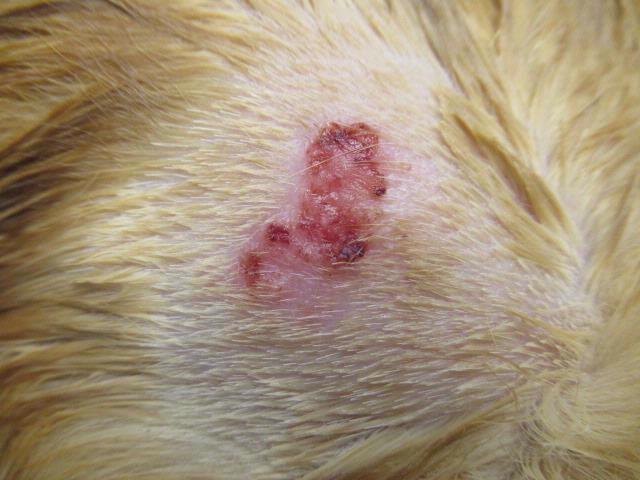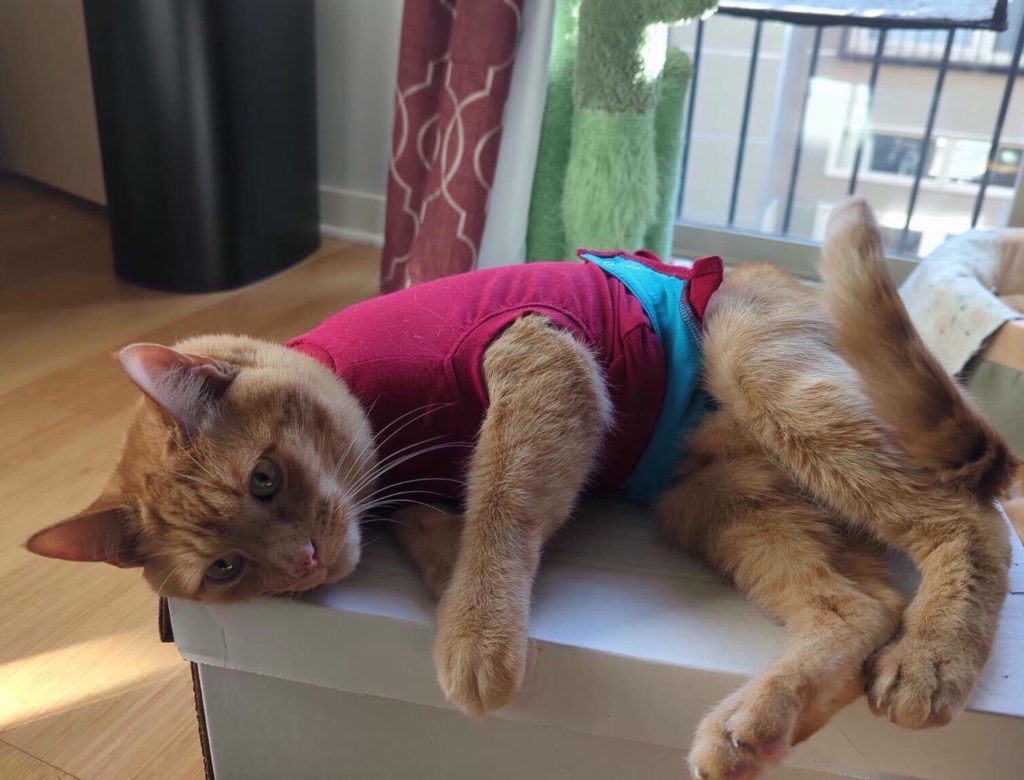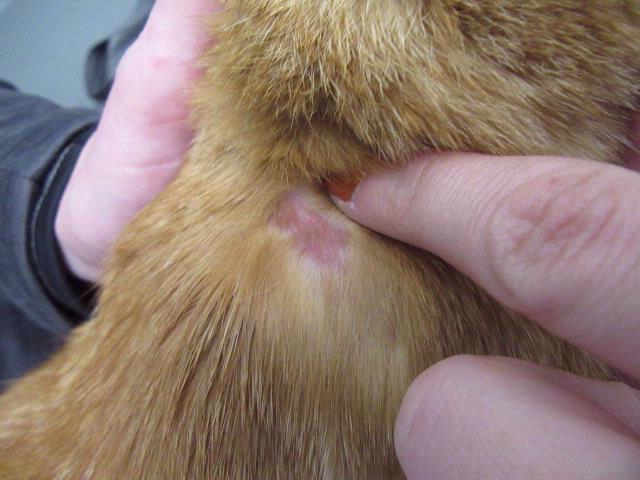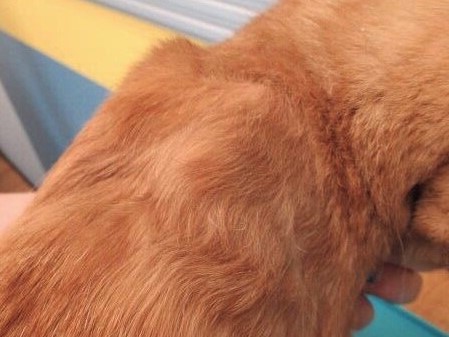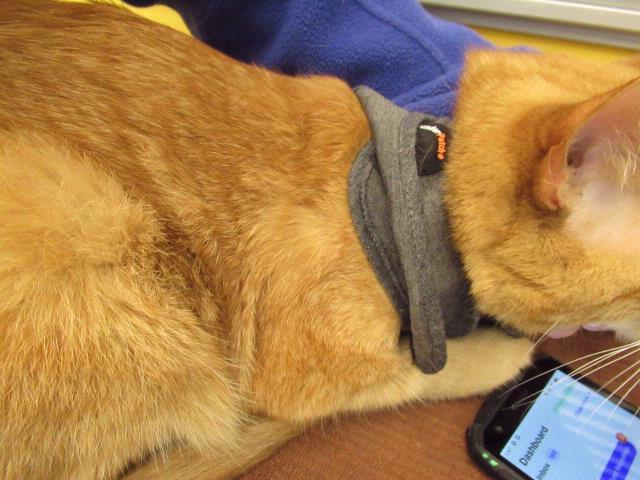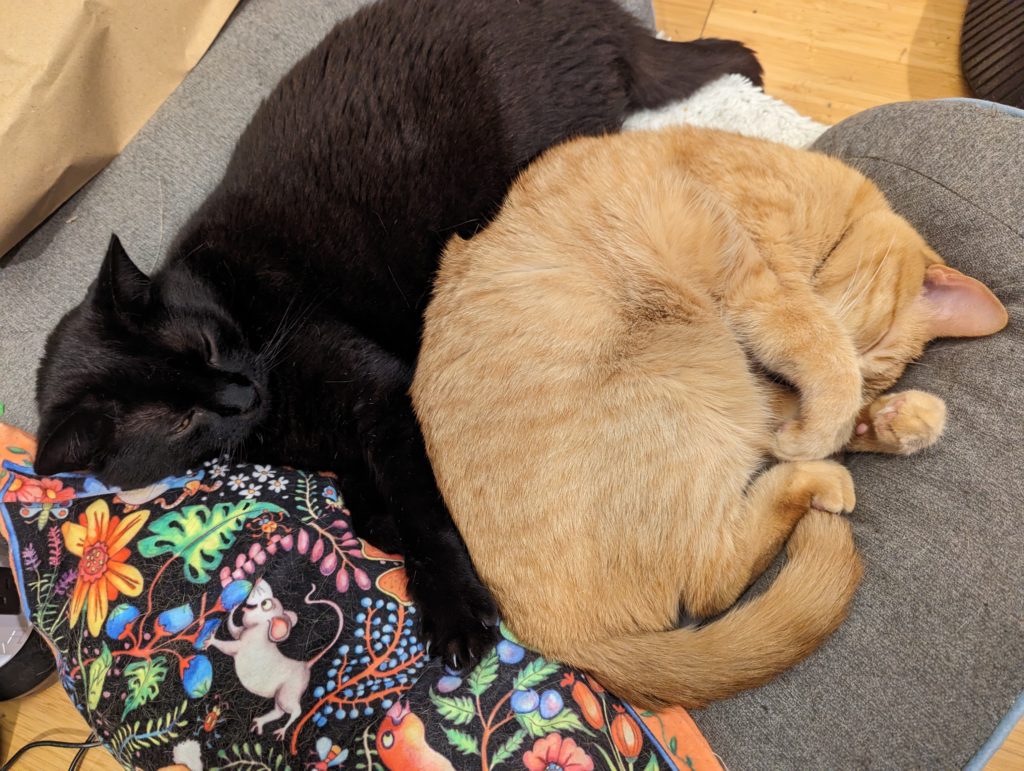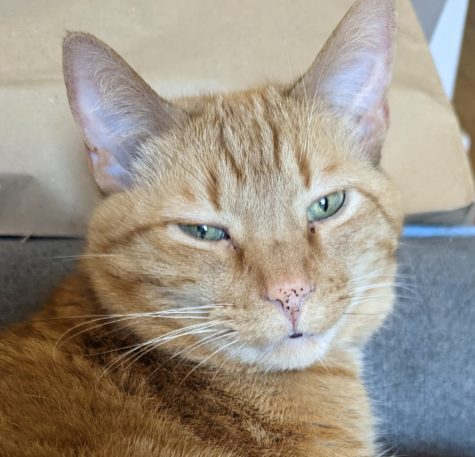
Our pet of the month for the month of September is Carrot.
Last fall we got a call from Carrot’s owner saying Carrot has a wound on his right shoulder with some bleeding that he had just noticed. He mentioned that this could be inflicted by another cat in the household but not entirely sure and Carrot does not seem to be in any pain. We were able to get Carrot the same day for the exam. The wound appeared to be on the right shoulder about 3 cm in size. The skin was excoriated with some scabbing and matted fur. While this could have been from a cat fight, we had concern that this could be a lesion associated with Feline Eosinophilic Syndrome.
The area was shaved and cleaned. Carrot was sent home with mild antiseptic solution for cleaning and topical ointment for healing. Two weeks later we got an update from his owner that his wound is healing well and fur is growing back. O was also keeping the area covered with a medical pet shirt to prevent any scratching or rubbing while the wound was still healing.
About a month later Carrot’s owner mentioned that the wound had improved a lot but not fully resolved so we had him come in for recheck. The skin in the area of the previous wound appeared to be red and inflamed but no actual wound. Carrot’s owner also mentioned that he scratches the area when pet shirt is removed.
With the non-healing wound and Carrot scratching the area, we discussed with Carrot’s owner that initially what appeared to be wound is likely a skin issue we should investigate in order to address it properly. Below are the few conditions that could explain Carrot’s symptoms
- Underlying allergies which include.
-
- Food allergy – The foods cats are most often allergic to include fish, beef, chicken, and milk products. It is the protein in these foods that triggers allergic reaction
- Environmental also known as atopy – Environmental allergens such as pollens, grasses, molds, mildew, and house dust mites
- Flea allergy- Cats are allergic to the proteins or antigens in flea saliva and one bite can cause severe reaction. Carrot was on good topical flea control.
- Ectoparasites – like skin mites, fleas, ticks etc.
- Skin Infection – This includes primary or secondary bacterial or fungal infection which can be superficial or deep.
- Eosinophilic Granuloma complex (EGC) – It is group of skin conditions that affects cats and is a form of hypersensitivity reaction to insects , fleas, food, or environmental allergens. The initial presentation of Carrot’s skin looked very suspicious of eosinophilic plaque ( one of the forms of EGC)
Because it was one particular spot that Carrot was scratching at, we also discussed and put together a list of disease processes which are not very common, but needed to be considered. This includes:
- Hyperesthesia Syndrome– It is an extreme sensitivity in an area of a cat’s skin, almost always on the back and often area in front of the tail. Cats often chase their tails and do intensive scratching of the area. Interestingly Carrot was already on a drug called Gabapentin which we started when he initially came to us to establish care but the area of concern was different and there was no wound present at that time.
- Complex regional Pain syndrome– Is a chronic pain disorder characterized by regionally confined pain that can lead to skin inflammation. The exact cause is not clear but nerve injury due to trauma is thought to be one of the potential causes. Again gabapentin is of the drugs that can be used to address it.
- Feline Idiopathic ulcerative dermatosis– It is a rare condition in cats resulting in self trauma and non-healing ulcer like changes on the skin between shoulders and back of the neck. Previously hypothesized to be reactions to injections as most of the vaccinations and medications are given in this area. Instead, this may be neuropathic itch from overstimulation of nerves.
- Skin neoplasia
With any skin disease it is very important we collect minimum database which includes skin scrape, skin cytology and blood work. The skin scrape did not show any evidence of mites, however, the skin cytology showed inflammation related to bacterial infection. We sent home oral antibiotics and topical ointment although it is difficult to know whether it is the primary reason for skin not healing but it is important to treat any concurrent infection. This helped in decreasing the skin redness and fur started to grow back.
But within a month after finishing the medications the redness came back and Carrot was still itchy. All the time Carrot’s owner was using the pet shirt to prevent Carrot from scratching the area. We recommended skin biopsy and transitioning Carrot to hypoallergenic food assuming food allergy contributing to skin changes. Skin biopsy can provide a valuable information about the cells in the area of abnormal skin and is often recommended in chronic skin changes/growths that fail to respond to treatment. Doing a skin biopsy in Carrot’s case can help to rule in or out the number of conditions we listed above.
While we were discussing with his owner about getting skin biopsy and have it analyzed by a Dermatopathologist, Carrot’s skin improved with continuation of topical ointment and physical barrier and skin biopsy was put on hold.
Even though the area almost looks like back to normal, Carrot was still going for that spot and we were almost certain that if we removed the pet shirt, the skin would become inflamed again due to self-trauma. At this point we strongly suggested starting a medication to control itching and hypoallergenic diet. Compared to dogs, fewer options are available in cats to control itch. We started Carrot on a drug called Atopica which is an immunosuppressant used to manage allergies in cats. It comes in liquid form and most cats do not like the taste so we recommend giving it with some wet food or tuna juice (unless they are on a food trial). It’s been 6 weeks since we started Carrot on Atopica and in the meantime he is also successfully transitioned to hypoallergenic food. Carrot’s skin looks great and itching is completely gone.
Skin is the largest organ in the body and skin problems are one of the top reasons dogs and cats are presented to veterinarians. Although allergies are very common in cats, it is very important to be aware of other disease processes which can lead to skin changes and signs/symptoms can overlap. Sometimes they require a multimodal approach for management. We are happy that Carrot is feeling so much better and appreciate his owner’s patience while we were working on Carrot’s case. Both Carrot and his owner are excited that Carrot is finally able to go without wearing his pet shirt or Thunder Shirt and he has remained comfortable and itch free.
LINKS WITH MORE INFORMATION:

